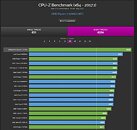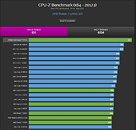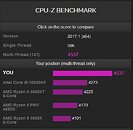- Joined
- Oct 9, 2007
- Messages
- 47,849 (7.39/day)
- Location
- Dublin, Ireland
| System Name | RBMK-1000 |
|---|---|
| Processor | AMD Ryzen 7 5700G |
| Motherboard | Gigabyte B550 AORUS Elite V2 |
| Cooling | DeepCool Gammax L240 V2 |
| Memory | 2x 16GB DDR4-3200 |
| Video Card(s) | Galax RTX 4070 Ti EX |
| Storage | Samsung 990 1TB |
| Display(s) | BenQ 1440p 60 Hz 27-inch |
| Case | Corsair Carbide 100R |
| Audio Device(s) | ASUS SupremeFX S1220A |
| Power Supply | Cooler Master MWE Gold 650W |
| Mouse | ASUS ROG Strix Impact |
| Keyboard | Gamdias Hermes E2 |
| Software | Windows 11 Pro |
Several benchmark numbers of the upcoming AMD Ryzen 7 5700G and Ryzen 5 5600G desktop processors were fished out by Thai PC enthusiast TUM_APISAK. The 5700G and 5600G are based on the 7 nm "Cezanne" silicon that combines up to 8 "Zen 3" CPU cores across a single CCX, sharing a single 16 MB L3 cache; along with an iGPU based on the "Vega" graphics architecture. Both chips were put through the CPU-Z Bench, where they posted spectacular results.
Both chips post higher single-thread score than the Core i9-10900K "Comet Lake," riding on the back of the high IPC of the "Zen 3" cores, and low latencies from the monolithic "Cezanne" silicon. In the multi-threaded test, the 8-core/16-thread 5700G scored above the Core i9-9900KS (5.00 GHz all-core). An HP OMEN 25L pre-built was put through Geekbench 5, where it was found performing within 90% of the Core i5-11600K. Userbenchmark remarks that the 5600X performs within the league of contemporaries, but falls behind on memory latency. Find the validation pages in the source links below.






View at TechPowerUp Main Site
Both chips post higher single-thread score than the Core i9-10900K "Comet Lake," riding on the back of the high IPC of the "Zen 3" cores, and low latencies from the monolithic "Cezanne" silicon. In the multi-threaded test, the 8-core/16-thread 5700G scored above the Core i9-9900KS (5.00 GHz all-core). An HP OMEN 25L pre-built was put through Geekbench 5, where it was found performing within 90% of the Core i5-11600K. Userbenchmark remarks that the 5600X performs within the league of contemporaries, but falls behind on memory latency. Find the validation pages in the source links below.






View at TechPowerUp Main Site


 .
.



